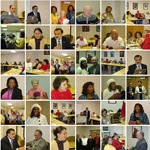Another important workshop linked social justice, intercultural relations, and intercultural communication in the global context. The session allowed participants to apply a theoretical approach to the complexities of globalizations across various disciplines and for community organizers.The next workshop I attended highlighted the Developmental Model of Intercultural Sensitivity (DMIS). It focuses on the stages that people move through in their acquisition of intercultural competence. This workshop focused on intercultural theory and its applications for educators, trainers, consultants, and non-profit employees. It provided a theoretical underpinning for many of the workshops presented during the institute. The presenter then discussed the development through the ethnocentric stage (denial, defense, minimization) and through ethnorelative stages (acceptance, adaptation, integration). And finally, I attended a session on film-based approaches for intercultural education. With a variety of film clips, this interactive session explored sequencing films and facilitating discussions in a manner most likely to improve multicultural understanding and intercultural competence. The facilitators applied the (DMIS) model to film selection and analysis. They explained how the power of film can transform attitudes and the way people view the world. Facilitators encouraged participants to consider the following when selecting films: (1) Do I show the entire film? (2) How do I deconstruct the film so it is not taken out of context? (3) How do I set the film up? (4)What type of pre-context assignment should I give to students to help them be prepared to move more quickly along the various levels of the model? (5) What films take students across a great divide culturally? (6) What films explore deeper cultural context and does not perpetuate stereotypes? (7) What films challenges their belief systems yet help them develop interculturally? (8) Did I leave enough time to the process the film with my students? (9) Which stage in the DMIS model are my students currently experiencing? (10) Does this film help them progress to a higher stage in the (DMIS) model?
- Chairy Tale
- Not In Our Town
- A Class Divided/The Essential
- Cold Water
- The Way Home
- True Colors
- Tale of/Land of O's (Update)
- Guess Whose Coming to Dinner
- Blue Eyed
- Ethnic Notions
- Skin Deep
- Powers of Ten
International
- Kandahar (Afghanstan)
- Himalya (Nepal)
- Heaven and Earth (Vietnam)
- Heart of the Dragon (China 12-part)
- Ghandi (India)
- Frida (Mexico
- Dersu Uzala (Russia)
- Search for the Afghan Girl (National Geographic)
- Schindler's List (Germany)
- Skyline (Spain)
- Tompopo (Japan)
- Three Seasons (Vietnam)
- The Way Home (Korea)
- Whale Rider (New Zealand)
- Crying Game (Ireland)
- Cry Freedom (South Africa)
- City of Joy (India)
- Heaven (Iran)
- Chariots of Fire (England)
Domestic USA - African American
- Amistad
- A Raisin In The Sun
- Boyz N The Hood
- Color Purple
- Do The Right Thing
- Eyes On The Prize I and II
- White Man's Burden
- Crash (highlights several ethnic groups)
- Fried Green Tomatoes
- Glory
- Ghosts Of Mississippi
- Grand Canyon
- Hoop Dreams
Domestic USA - Asian
- Come See The Paradise
- Daughter from Danag (PBS)
- Dim Sum
- Dragon: The Bruce Lee Story
- Double Happiness (Canada)
- Eat a Bowl of Tea
- American Game Japanese Rules
- Becoming American
- Blue Collar Buddha
- Carved in Silence
- Great Wall
- Green Dragon
- Joy Luck Club
- Karate Kid
- Picture Bride
Domestic USA - Latino/Hispanic
- Real Women Have Curves
- Selena
- Spanglish
- Stand and Deliver
- Tortilla Shop
- West Side Story
- Chicano! (4 part)
- El Norte
- Fools Rush In
- La Bamba
- Lone Star
- Mi Familia/My Family
Domestic USA - Native American
- Black Robe (Canada)
- Dance Me Outside (Canada)
- Dances With Wolves
- Fast Runner
* I invite each of you to add films for cross-cultural learning.
